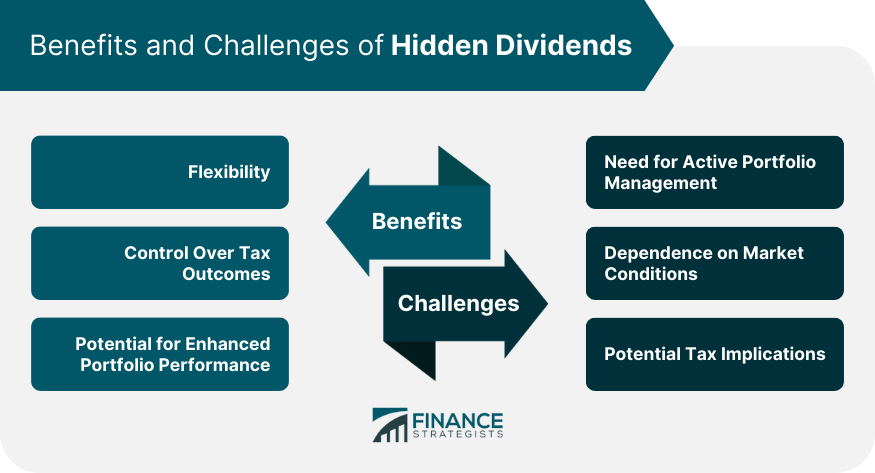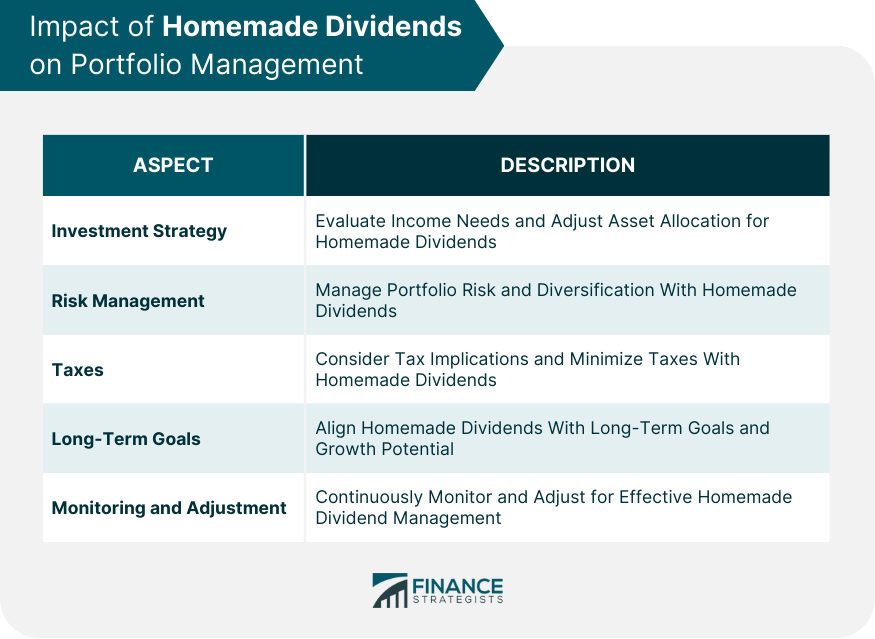Homemade dividends are a concept rooted in financial theory. They represent the idea that investors can create their dividends by selling a portion of their stock. The process involves an investor selling off part of their portfolio to create cash flow, akin to receiving a dividend from a company. The concept of homemade dividends stems from the Modigliani-Miller theorem, a cornerstone of modern corporate finance theory. According to this theorem, in a perfect market with no taxes, bankruptcy costs, or asymmetric information, a company's value is not affected by how it is financed or its dividend policy. In other words, investors can create their dividends by selling portions of their equity holdings, irrespective of whether the company itself pays dividends. Companies often have different policies regarding dividend distributions. Some companies may not distribute dividends, especially those in growth or reinvestment phases, as they may prefer to reinvest their earnings back into the business. In such scenarios, homemade dividends allow investors to generate cash flow from their investments, despite the lack of actual dividend distributions. Unlike traditional dividends, which are distributed according to a company's predetermined schedule, homemade dividends allow investors to decide when and how much cash to generate from their investments. This flexibility can be beneficial for investors with irregular cash flow needs, such as those who are self-employed or have variable income. During market highs, when the investor's shares have appreciated significantly, selling off a part of the investment to create a homemade dividend could lock in profits. This strategy could be beneficial in case the market adjusts and the share prices fall. Investors can take advantage of the high market prices to generate income. Unlike conventional dividends that companies pay out according to a set schedule, homemade dividends allow investors to generate income when they need it. This characteristic is particularly advantageous for investors who require a non-standard cash flow. When companies distribute dividends, they are typically subject to taxes at the investor's marginal tax rate. In contrast, with homemade dividends, investors can time their stock sales to manage their overall tax liability. Since this strategy does not rely on receiving dividends from a company, investors can choose from a broader range of companies, including those that do not pay dividends. These companies often reinvest their earnings to fuel growth, which can lead to an appreciation in their stock price. Investors must continuously monitor their investments, staying abreast of any significant changes in the market. This continuous oversight can be time-consuming and requires a deep understanding of market trends and financial indicators. The ability to generate homemade dividends hinges heavily on favorable market conditions. If an investor's shares haven't appreciated in value due to market downturns, selling them might not generate a significant income or could even result in a loss. When an investor sells shares to generate a homemade dividend, they might trigger a capital gains tax event. If the shares have significantly increased in value since their purchase, the investor could be liable for substantial capital gains tax. Implementing a homemade dividends strategy requires careful consideration of one's investment strategy. Investors need to assess their income needs and determine the amount of cash flow required from their portfolio. By selling a portion of their investments to generate homemade dividends, they may need to adjust their asset allocation and investment selections accordingly. This strategy may involve selling securities that have appreciated in value or reallocating investments to assets that generate more consistent cash flow. Homemade dividends can influence the risk profile of a portfolio. Selling assets to generate cash flow can reduce the overall value of the investment portfolio, potentially impacting diversification and exposing the portfolio to higher risks. Investors must evaluate the impact of selling securities on their portfolio's risk-return characteristics. Maintaining a balanced approach that considers risk tolerance, investment goals, and the need to preserve capital is crucial. Homemade dividends may have tax implications that can affect portfolio management decisions. Investors may be subject to capital gains taxes when selling investments to generate cash flow. Understanding the tax consequences and considering strategies to minimize the tax burden is important. This could involve selling securities with lower gains or utilizing tax-efficient investment accounts such as individual retirement accounts (IRAs) or tax-deferred accounts. Homemade dividends should align with an investor's long-term goals. The strategy of generating income by selling assets may be suitable for investors seeking regular cash flow or those in need of immediate income. However, it's important to ensure that the strategy keeps the long-term growth potential of the portfolio intact. Evaluating the impact on long-term goals, such as retirement planning or funding future financial needs, is crucial when implementing homemade dividends. Managing a portfolio that relies on homemade dividends requires ongoing monitoring and adjustments. Regular evaluation of income needs, market conditions, and investment performance is necessary to ensure the strategy remains effective. Investors should stay informed about the performance of their investments and be prepared to make adjustments as needed. This may involve rebalancing the portfolio, reassessing income requirements, or adapting the strategy based on changing market dynamics. Homemade dividends allow investors to create their own cash flow by selling a portion of their stock holdings, even if the company does not distribute dividends. They provide flexibility in generating income and control over tax outcomes while potentially enhancing portfolio performance by investing in a broader range of companies. However, implementing a homemade dividends strategy requires active portfolio management, as investors need to monitor market conditions and understand potential tax implications. It is crucial to align the strategy with long-term goals, considering risk management and the impact on portfolio diversification. Regular monitoring and adjustments are necessary to ensure the strategy remains effective. By evaluating income needs, market trends, and investment performance, investors can make informed decisions to meet their financial objectives. Homemade dividends offer an alternative method for generating income, but careful consideration of various factors is essential for successful implementation.What Are Homemade Dividends?
Situations When Homemade Dividends Can Be Beneficial
Low Dividend Payout by Companies
Investor's Need for Regular Income
During Market Highs
Benefits of Homemade Dividends
Flexibility
Control Over Tax Outcomes
Potential for Enhanced Portfolio Performance
Challenges of Homemade Dividends
Need for Active Portfolio Management
Dependence on Market Conditions
Potential Tax Implications

How Homemade Dividends Affect Portfolio Management
Investment Strategy
Risk Management
Taxes
Long-Term Goals
Monitoring and Adjustment

Conclusion
Homemade Dividends FAQs
Homemade dividends refer to a strategy employed by investors to create their own dividend income by selling a portion of their investment holdings instead of relying on dividends distributed by companies.
Investors generate homemade dividends by selling a portion of their investment portfolio. This allows them to create a cash flow similar to traditional dividends without relying on the dividend payouts of the companies they invest in.
Homemade dividends provide investors with more control over their cash flow. They can tailor the timing and amount of the dividends to their specific needs. Additionally, investors can potentially minimize taxes since homemade dividends may be subject to lower tax rates than traditional dividends.
Homemade dividends may suit investors who prefer more flexibility and control over their income. However, it is essential to consider factors such as transaction costs, tax implications, and the potential impact on the overall investment portfolio before implementing this strategy.
When using the homemade dividends strategy, investors should consider factors such as the impact on their long-term investment goals, the potential for capital gains taxes, transaction costs associated with selling securities, and the need to maintain a diversified investment portfolio. Consulting with a financial advisor can provide personalized guidance based on individual circumstances.
True Tamplin is a published author, public speaker, CEO of UpDigital, and founder of Finance Strategists.
True is a Certified Educator in Personal Finance (CEPF®), author of The Handy Financial Ratios Guide, a member of the Society for Advancing Business Editing and Writing, contributes to his financial education site, Finance Strategists, and has spoken to various financial communities such as the CFA Institute, as well as university students like his Alma mater, Biola University, where he received a bachelor of science in business and data analytics.
To learn more about True, visit his personal website or view his author profiles on Amazon, Nasdaq and Forbes.











